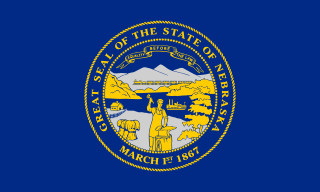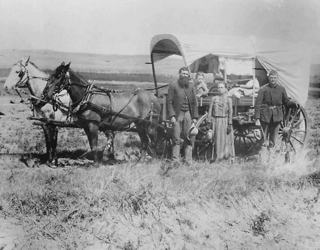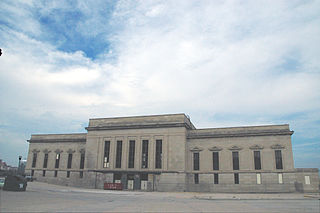
Nebraska is a triply landlocked state in the Midwestern region of the United States. It borders South Dakota to the north; Iowa to the east and Missouri to the southeast, both across the Missouri River; Kansas to the south; Colorado to the southwest; and Wyoming to the west. Nebraska is the 16th largest state by land area, with just over 77,220 square miles (200,000 km2). With a population of over 1.9 million, it is the 38th most populous state and the 7th least densely populated. Its capital is Lincoln, and its most populous city is Omaha, which is on the Missouri River. Nebraska was admitted into the United States in 1867, two years after the end of the American Civil War. The Nebraska Legislature is unlike any other American legislature in that it is unicameral, and its members are elected without any official reference to political party affiliation. Nebraska is one of only two states that divide electoral college votes by district, and is not winner-take-all.

Omaha is the most populous city in the U.S. state of Nebraska and the county seat of Douglas County. It is located in the Midwestern United States along the Missouri River, about 10 mi (15 km) north of the mouth of the Platte River. The nation's 40th-most populous city, Omaha had a population of 486,051 as of the 2020 census. It is the anchor of the eight-county Omaha–Council Bluffs metropolitan area, which extends into Iowa and is the 58th-largest metro area in the United States, with a population of 967,604. Furthermore, the greater Omaha–Council Bluffs–Fremont combined statistical area had 1,004,771 residents in 2020.

Council Bluffs is a city in and the county seat of Pottawattamie County, Iowa, United States. The population was 62,799 at the 2020 census, making it the state's tenth most populous city, and the most populous city in Southwest Iowa. The Omaha metropolitan region of which Council Bluffs is a part, is the 58th largest in the United States, with an estimated population of 983,969 (2023). It is located on the east bank of the Missouri River, across from Omaha, Nebraska. Until about 1853 Council Bluffs was known as Kanesville. Kanesville was the historic starting point of the Mormon Trail. Kanesville is also the northernmost anchor town of the other emigrant trails because there was a steam-powered boat which ferried the settlers' wagons and cattle across the Missouri River. In 1869, the first transcontinental railroad to California was connected to the existing U.S. rail network at Council Bluffs.

Atkinson is a city in Holt County, Nebraska, United States. The population was 1,245 at the 2010 census.

The Territory of Nebraska was an organized incorporated territory of the United States that existed from May 30, 1854, until March 1, 1867, when the final extent of the territory was admitted to the Union as the state of Nebraska. The Nebraska Territory was created by the Kansas–Nebraska Act of 1854. The territorial capital was Omaha. The territory encompassed areas of what is today Nebraska, Wyoming, South Dakota, North Dakota, Colorado, and Montana.

The Chicago, Burlington and Quincy Railroad was a railroad that operated in the Midwestern United States. Commonly referred to as the Burlington Route, the Burlington, CB&Q, or as the Q, it operated extensive trackage in the states of Colorado, Illinois, Iowa, Missouri, Nebraska, Wisconsin, Wyoming, and also in Texas through subsidiaries Colorado and Southern Railway, Fort Worth and Denver Railway, and Burlington-Rock Island Railroad. Its primary connections included Chicago, Minneapolis–Saint Paul, St. Louis, Kansas City, and Denver. Because of this extensive trackage in the midwest and mountain states, the railroad used the advertising slogans "Everywhere West", "Way of the Zephyrs", and "The Way West".

Fort Atkinson was the first United States Army post to be established west of the Missouri River in the unorganized region of the Louisiana Purchase of the United States. Located just east of present-day Fort Calhoun, Nebraska, the fort was erected in 1819 and abandoned in 1827. The site is now known as Fort Atkinson State Historical Park and is a National Historic Landmark. A replica fort was constructed by the state at the site during the 1980s–1990s.
The St. Joseph and Grand Island Railroad (SJ&GI) had its start as the St Joseph and Denver City Railroad which, after several changes of destination, was completed as the St Joseph and Western (SJ&W) between St Joseph, Missouri and Hastings, Nebraska in 1872.

The Nebraska Northeastern Railway was a shortline railroad that began operations on July 23, 1996, in northeastern Nebraska. It operates on about 120 miles of former Burlington Northern Railroad track between Ferry Station, NE and O'Neill, Nebraska, as well as trackage rights over the BNSF Railway, Burlington Northern's successor, into Sioux City, Iowa.
The Fremont, Elkhorn and Missouri Valley Railroad (FE&MV), sometimes called "the Elkhorn," was a railroad established in 1869 in the state of Nebraska in the Midwestern United States.

The Burlington and Missouri River Railroad (B&MR) or sometimes (B&M) was an American railroad company incorporated in Iowa in 1852, with headquarters in Omaha, Nebraska. It was developed to build a railroad across the state of Iowa and began operations in 1856. It was acquired by the Chicago, Burlington and Quincy Railroad in 1872, and kept serving as its subsidiary.

The term drumhead refers to a type of removable sign that was prevalent on North American railroads of the first half of the 20th century. The sign was mounted at the rear of named passenger trains, and consisted of a box with internal illumination that shone through a tinted panel bearing the logo of the railroad or specific train. Since the box and the sign were usually circular in shape and resembled small drums, they came to be known as drumheads.

The Tazewell & Peoria Railroad (T&P) is a short-line railroad, running entirely in Peoria County and Tazewell County, Illinois, and formed by Genesee & Wyoming Inc. to lease the assets of the century-old Peoria and Pekin Union Railway (P&PU), which is owned by Union Pacific, Norfolk Southern and Canadian National. It switches close to 100,000 cars per year and has about 142 miles of track. Genesee & Wyoming owns 81 miles of TZPR and can handle freight cars with up to 286,000 pounds of cargo.

The history of the U.S. state of Nebraska dates back to its formation as a territory by the Kansas–Nebraska Act, passed by the United States Congress on May 30, 1854. The Nebraska Territory was settled extensively under the Homestead Act of 1862 during the 1860s, and in 1867 was admitted to the Union as the 37th U.S. state. The Plains Indians are the descendants of a long line of succeeding cultures of indigenous peoples in Nebraska who occupied the area for thousands of years before European arrival and continue to do so today.

Mexicans in Omaha are people living in Omaha, Nebraska, United States who have citizenship or ancestral connections to the country Mexico. They have contributed to the economic, social and cultural well-being of Omaha for more than a century. Mexicans, or Latino people identified incorrectly as being from Mexico, have been accounted for in the history of Omaha, Nebraska since 1900. The entire Latino population of Omaha increased ninety percent between 1990 and 1997.

Railroads in Omaha, Nebraska, have been integral to the growth and development of the city, the state of Nebraska, the Western United States and the entire United States. The convergence of many railroad forces upon the city was by happenstance and synergy, as none of the Omaha leaders had a comprehensive strategy for bringing railroads to the city.

Atkinson Township is one of thirty-seven townships in Holt County, Nebraska, United States. The population was 1,744 at the 2020 census. A 2023 estimate placed the township's population at 1,741.

The Union Pacific Railroad Omaha Shops Facility was a 100-acre (0.40 km2) shop for the trains of the Union Pacific located at North 9th and Webster in Downtown Omaha. With the first locomotives arriving in 1865, it took until the 1950s for the facility to become the major overhaul and maintenance facility for the railroad. This lasted until 1988 when UP moved most of the operations out-of-state. Demolition began soon afterwards.
The Washington County Historical Association, or WCHA, is located in the Washington County Historical Museum at 102 North 14th Street in Fort Calhoun, Nebraska. The WCHA "promotes careful guardianship of historical artifacts, promotes an understanding of their significance and inspires people to turn things learned and appreciated into benchmarks for their lives."















